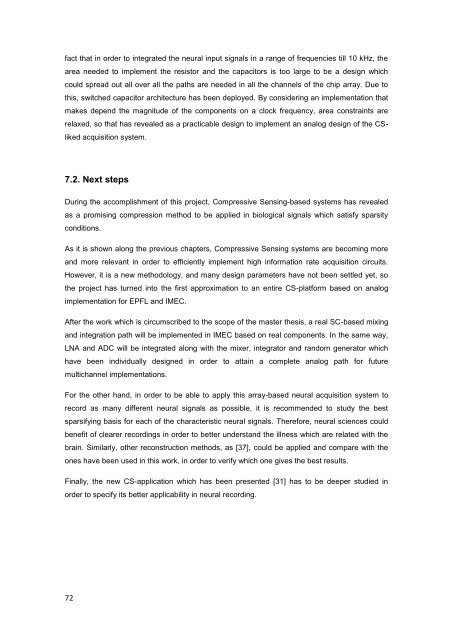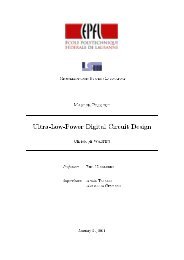Compressive Sensing system for recording of ECoG signals in-vivo
Compressive Sensing system for recording of ECoG signals in-vivo
Compressive Sensing system for recording of ECoG signals in-vivo
Create successful ePaper yourself
Turn your PDF publications into a flip-book with our unique Google optimized e-Paper software.
fact that <strong>in</strong> order to <strong>in</strong>tegrated the neural <strong>in</strong>put <strong>signals</strong> <strong>in</strong> a range <strong>of</strong> frequencies till 10 kHz, thearea needed to implement the resistor and the capacitors is too large to be a design whichcould spread out all over all the paths are needed <strong>in</strong> all the channels <strong>of</strong> the chip array. Due tothis, switched capacitor architecture has been deployed. By consider<strong>in</strong>g an implementation thatmakes depend the magnitude <strong>of</strong> the components on a clock frequency, area constra<strong>in</strong>ts arerelaxed, so that has revealed as a practicable design to implement an analog design <strong>of</strong> the CSlikedacquisition <strong>system</strong>.7.2. Next stepsDur<strong>in</strong>g the accomplishment <strong>of</strong> this project, <strong>Compressive</strong> <strong>Sens<strong>in</strong>g</strong>-based <strong>system</strong>s has revealedas a promis<strong>in</strong>g compression method to be applied <strong>in</strong> biological <strong>signals</strong> which satisfy sparsityconditions.As it is shown along the previous chapters, <strong>Compressive</strong> <strong>Sens<strong>in</strong>g</strong> <strong>system</strong>s are becom<strong>in</strong>g moreand more relevant <strong>in</strong> order to efficiently implement high <strong>in</strong><strong>for</strong>mation rate acquisition circuits.However, it is a new methodology, and many design parameters have not been settled yet, sothe project has turned <strong>in</strong>to the first approximation to an entire CS-plat<strong>for</strong>m based on analogimplementation <strong>for</strong> EPFL and IMEC.After the work which is circumscribed to the scope <strong>of</strong> the master thesis, a real SC-based mix<strong>in</strong>gand <strong>in</strong>tegration path will be implemented <strong>in</strong> IMEC based on real components. In the same way,LNA and ADC will be <strong>in</strong>tegrated along with the mixer, <strong>in</strong>tegrator and random generator whichhave been <strong>in</strong>dividually designed <strong>in</strong> order to atta<strong>in</strong> a complete analog path <strong>for</strong> futuremultichannel implementations.For the other hand, <strong>in</strong> order to be able to apply this array-based neural acquisition <strong>system</strong> torecord as many different neural <strong>signals</strong> as possible, it is recommended to study the bestsparsify<strong>in</strong>g basis <strong>for</strong> each <strong>of</strong> the characteristic neural <strong>signals</strong>. There<strong>for</strong>e, neural sciences couldbenefit <strong>of</strong> clearer <strong>record<strong>in</strong>g</strong>s <strong>in</strong> order to better understand the illness which are related with thebra<strong>in</strong>. Similarly, other reconstruction methods, as [37], could be applied and compare with theones have been used <strong>in</strong> this work, <strong>in</strong> order to verify which one gives the best results.F<strong>in</strong>ally, the new CS-application which has been presented [31] has to be deeper studied <strong>in</strong>order to specify its better applicability <strong>in</strong> neural <strong>record<strong>in</strong>g</strong>.72















